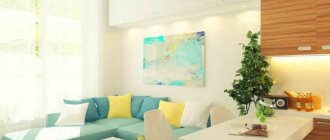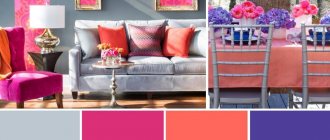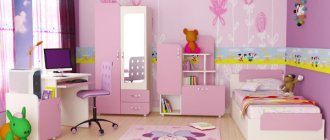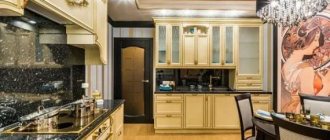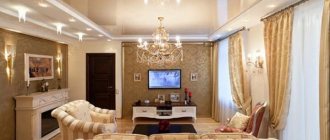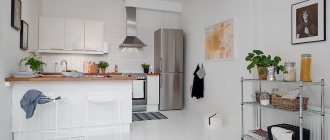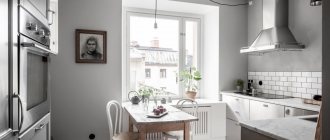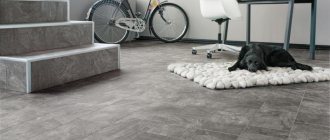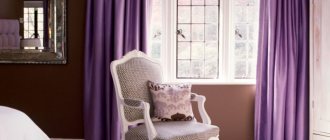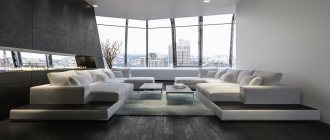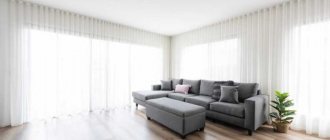If you are from that generation of people who, in deep childhood, looked at the carpet hanging on the wall before going to bed and found it beautiful, then you are probably of little concern about the problem of the correct combination of color variations in the room. Or doesn't care at all. And it’s completely in vain: under successful circumstances, the ability to correctly solve design problems will allow you to transform even the most modest apartment with a minimal investment of material resources. You may not become a designer, but you must be able to select shades - let us allow ourselves a free paraphrase of Nekrasov’s famous poem and invite you to learn the correct combination of colors in the interior with the help of auxiliary tables and photos. We are interested in literally everything - the floor, walls, furniture and, of course, the ceiling.
Why is it so important to be able to combine colors in the interior?
- influence on a person’s behavioral model;
- creating a cozy environment and an atmosphere of relaxation and peace;
- compliance with the stylistic originality of interiors;
- creating a complete impression of the room;
- visual transformation of space;
- masking structural defects of the room.
In order to achieve the intended goal, it is important to calculate not only the contours of the interior, but also the atmosphere that certain colors and shades create. Study our table of combinations of popular colors in the interior and avoid common mistakes!
| Main color | Good combination | Bad combination | Influence/Who is suitable for | Style |
| White | With all the colors and their shades | Absent | Cool, noble appearance, universal for people of all character types | Any |
| Black | Red, grey, white, yellow, green | Pink, beige, lilac | Narrows the room, causes anxiety and fear | Loft, contemporary, minimalism, hi-tech |
| Red | Blue, green, grey, gold, yellow, black | Purple, chestnut, brown | Excites, promotes increased activity, ideal for hard workers and choleric people | Classic, contemporary, art |
| Yellow | Grey, purple, brown, green, black | Lilac, blue, burgundy, pink | Illuminates a dark room, improves vitality, gives comfort and greatly invigorates | Classic, Provence, art |
| Green | Red, black, burgundy, yellow, orange | Grey, purple, blue | Calms, relaxes, creates a cozy atmosphere in the shower and interior | Classic, Provence, art, minimalism |
| Blue | Red, orange, blue, light purple | Golden, yellow, burgundy | Brings shades of cold, requires moderate use | All |
| Blue | Red, grey, burgundy, gold | Green, lilac, brown | Moderately cool color, also requires careful use, suitable for bachelors and people prone to solitude | All |
| Brown | Golden, grey, beige, pink, yellow | Chestnut, burgundy, lilac | Home comfort, if too much, can cause a bad mood and depressive thoughts | Classic, Provence |
| Pink | Brown, gray, burgundy | Yellow, orange, black | Romantic mood, ideal for sensual natures | Classic, Provence, contemporary |
| Violet | Light green, golden, orange, yellow | Dark green, brown, red, gray | Calmness and balance, for creative people | All |
| Lilac | Grey, chestnut, light purple | Red, orange, yellow, brown, black | Introduces an element of mystery, intrigue, fabulous mystery, best revealed in the eyes of extraordinary eccentric natures | Everything except minimalism and loft |
| Grey | Blue, pink, brown, yellow, red, black, blue, lilac | Green, orange | Despite popularity - despondency, existential sadness, choice of melancholics and introverts prone to isolation | Loft, minimalism, hi-tech |
| Orange | White, black, green, gold | Red, lilac | Positive light color, promotes good mood, smiles and a healthy atmosphere; not suitable for people engaged in intellectual work, as it distracts | Classic, art |
| Cream | Chocolate, pastel colors, pistachio | None | Graceful and relaxed, perfect for sensual people and not recommended for those prone to increased activity | Classic, Provence, contemporary, minimalism, shabby chic |
The correct combination of colors in the interior is a subject of science, which has a sonorous and proud name coloristics
. Unfortunately, our culture of selecting and combining colors is not well developed even in a professional environment - and this is evidenced by numerous examples of frankly uncomfortable, unattractive interiors that reek of boredom, discomfort and the day before yesterday.
Everything you saw above is a consequence of an incorrect combination of the color scheme of the room, when instead of the desired harmony, terrible tension hangs in the space, and every detail of the interior causes unbearable irritation. A properly designed interior makes an extremely positive impression due to the direct impact on the psychological state of a person and the skillful processing of his visual receptors.
In interior design, almost everything is important: the color of the floor, ceiling, wall surfaces, the order of selection of furniture and its integration into the living space.
Some of the most common rules for combining colors in the interior are well known to you even without tables and additional photos - for example, the combination of white and black
, two popular contrasting shades. Playing on contrasts, by the way, is one of the favorites among property owners, as it allows you to add additional notes to the visual design of the room.
How to decide on a color?
There are many different theories regarding which paints to use for certain spaces. At the same time, you decide for yourself which color scheme you feel best in.
For example, there are people who love their homes decorated in black, red and white. And for some, this combination has a negative effect, because it increases blood pressure and provokes the release of adrenaline.
The first question a designer asks his clients is: “What is your favorite color?” And if family members cannot come to a common opinion, the specialist tries to combine their favorite shades in a single combination and find compromises that suit the customers.
Where to begin
Everyone knows how to paint a ceiling - what could be simpler? It’s more difficult with walls, especially if we are talking about painting the walls in several colors. The mechanism for painting with different colors is the same for both walls and wallpaper for painting.
1. Choose a color combination. You already have a rough idea of what combinations are close to you: calm or rich, smoothly flowing into each other or contrasting. You can select colors based on four types of combinations:
Tones of the same color, different in saturation and intensity.
Coordinating color palette (neutrals, pastels).
Different colors that set off each other in contrast. In the diagram they are opposite each other.
Using white color, which is 100% compatible with any color.
2. Choose a color scheme.
Colors that will be repeated in the interior or furniture elements will add special coziness and comfort to the room.
Cool colors will visually expand the room and add severity and sedateness.
Pastel colors that play with natural shades will make the room more tangible and warm.
3. Make sure you have a sufficient amount of tinted paint. If you suddenly run out of material for work, it will be difficult to achieve accurate tinting. It is necessary to prepare masking tape for work, which allows you to carry out the work cleanly when painting and delimit the space of the walls.
4. It is not always possible to follow a strict line when painting walls in two colors, so you need to think about finishing at the joints: borders, decorative stones, frames, mosaics - all this is suitable for effectively decorating walls of different colors.
In the video: a painting method that does not require masking tape.
The table for color combinations of floors, ceilings, walls and furniture in the kitchen interior is simple and clear
The interior of the kitchen contains quite a lot of different elements that should be carefully selected for each other.
The color scheme, which can be matched to any design, should complement all the accompanying elements of the kitchen. In this situation, it is important not to oversaturate the working surface with colorful paints.
- As a rule, kitchens are made in grayish shades, with the addition of wood and chrome elements. This combination will easily harmonize with any kitchen utensils and interior elements.
- If you make a kitchen in light gray tones, coffee would be an excellent color for the floor, but the ceiling will be painted in a darker shade of gray.
- To dilute the gray look, yellow or red elements are used to paint kitchen cabinets.
Minimalism in details is important in the kitchen. This effect is achieved by adding discreet details to the interior. An example of this could be a lamp or vases with flowers, which will create a certain atmosphere.
Features of the color of flooring in the kitchen
In the kitchen and in the hallway, unlike other rooms, you can use tiles or linoleum, which gives considerable scope for imagination. And there are no limits here, because in the kitchen you can put bright red, yellow, green tiles, and to avoid excessiveness, alternate them with white. By correctly combining this floor design with the tiles on the walls and the color of the facades, you will achieve a cheerful and cheerful atmosphere. In such a kitchen you will want to create exquisite and original dishes.
Related article: Tile flooring in the hallway: combination, advantages, disadvantages
However, strict flooring colors are also popular in the kitchen. This is a classic style, Provence (How to decorate a kitchen in Provence style: tips and tricks), which has beauty realized in natural colors. The current trends in kitchen flooring are laminate flooring that imitates powerful oak floors in ash, chocolate and almost black colors.
When choosing Provence, keep in mind that the entire kitchen interior must match. Everything in a rustic style should be in harmony: textiles match the wallpaper, the shade of the furniture matches the floor.
The combination of colors of furniture, walls, ceiling and floor in the bedroom interior
The bedroom is intended for relaxation and privacy of a person. The elements and colors of the final interior should create a pleasant, calm and cozy atmosphere.
Choosing paints for the bedroom is quite simple, since there is a simple table specifically for this living space.
The main color of the room is selected based on the concept chosen by the designer. Most often, bedrooms are made in a beige shade, with the addition of dark wood elements.
This combination will create an atmosphere of comfort and privacy, which is what they most often try to achieve when creating the interior in these rooms.
The walls of the room must be made in calm, preferably coffee tones. The floor is made of dark wood, which will go well with wooden inserts in furniture of the same color.
If we talk about a bedroom in bright colors, in this case there is even more variety. Most bright shades match each other both in furniture and decorative elements.
Features of attic ceilings
Ceilings in the attic are formed directly by the roof plane and have a rather complex structure. However, this does not prevent almost any person from mastering it.
Scheme of the attic roofing pie
- Roofing covering. Its role can be: flexible tiles, metal tiles, ondulin or slate.
- Lathing.
- Counter-lattice.
- Waterproofing film.
- Insulation.
- Vapor barrier membrane.
- Finish coating.
Finish coating
If the design of the roofing pie remains unchanged in almost any case, then with the finishing coating things are completely different. A huge field for maneuver opens up here.
The ceiling lining in the attic is made with natural materials, for example: imitation timber, lining, parquet boards, plywood. Less commonly used in finishing are plasterboard and suspended ceilings.
Table of combinations of shades in the interior of a hall decorated in light colors
Designers know all the secrets that allow them to tastefully decorate any room. There is a table of color combinations for the ceiling, floor, furniture and walls in the interior of a room decorated in light colors, by which they are guided.
It is a fact that different shades give the room harmony and coziness. The choice of flooring is the main task, since its structure, color and pattern are fundamental for the further selection of tones and shades of wallpaper, ceiling, choice of doors and furniture.
For the decoration of the hall, cream color and its shades, as well as yellow, are suitable. The use of light colors visually enlarges the room, improves mood and calms.
If the flooring in the hall is dark in color, then the walls and ceiling should be light, almost white. Pastel colors allow you to create a feeling of spring in your apartment.
In addition, the room becomes lighter and more spacious. A combination of three or more colors in the interior allows you to turn the room into a fairy-tale world.
Harmony is achieved by combining wood flooring and delicate shades of walls, ceilings, doors and furniture. The combination of pink, blue, lilac and turquoise shades of vertical surfaces can be diluted with yellow and orange details.
A white ceiling is considered universal in any style. Designers recommend using peach, sand and pink shades in dimly lit rooms, while in brightly lit rooms it is better to use blue, turquoise or lilac shades.
Earlier, in one of the articles, we looked in more detail at what the combination of colors could be in the interior of a hall and other rooms. For those interested, follow the link and study!
Ceiling finishing technologies
Combination of colors in the interior
It is almost impossible to answer the question “What color to choose for the ceiling surface?” without knowing exactly how the ceiling will be finished. That is why we will begin our discussion of the ceiling palette not with the choice of one color or another, but with an analysis of the ceiling finishing options available to us.
So, how can we finish the ceiling:
Ceiling and walls in a single palette
- The first technology that comes to mind is traditional. The ceiling needs to be plastered until a smooth surface is obtained, then putty, and only then proceed to finishing. Whitewash, interior paint, decorative plaster or wallpaper can be used as a finishing material. If you exclude whitewash, then the modern range of paints and colored plasters allows you to get a ceiling of almost any shade. We can make a combination of walls and ceiling of the same color, paint them in contrasting colors, apply a pattern or decorate the ceiling in another way...
- The next method is to install a suspended ceiling. This technology involves installing a frame on the ceiling, which is then covered with plasterboard sheets. And then everything is the same as in the first case: you can paint it, you can finish it with plaster, you can glue wallpaper. The main difference between suspended ceilings is that they provide an almost perfectly flat surface. And when finishing, we have to think about how to choose the color of the ceiling - and not about how to mask the unevenness of the ceiling.
- A type of suspended ceilings that deserves special mention are modular ceilings, i.e. ceilings made of individual elements that do not require painting or plastering. These are primarily slatted ceilings, ceilings made of plastic panels, and also Armstrong modular suspended ceilings. In the case of such a ceiling, the answer to the question of what color scheme to choose lies in the selection of ceiling panels of the required shade. On the one hand, you don’t need to bother with paint palettes, but on the other hand, you may not find the right shade.
Colored panels for suspended ceiling Armstrong
Palette of suspended ceilings
As you can see, the variety of finishing methods gives rise to an expansion of the palette of our future ceiling. Therefore, if you have decided which technology you will use to make your ceiling, let’s decide which combination of colors for the walls and ceiling will be the best!
Subtleties of color combinations in the living room
To create coziness and comfort in the apartment, the designers have developed a table that indicates the subtleties of combining the colors of walls, furniture, floors and ceilings in the interior of the living room and other rooms.
An excellent option would be to combine a dark wooden floor with beige walls, a white ceiling and gray furniture. You can use a monochrome design and halftones.
In this case, shades of the same color are combined, only large surfaces are made in the lightest shades, and the furniture is chosen several shades darker.
A living room with dark walls and light floors, ceilings and utensils looks good. It is more difficult to choose a combination of shades that are almost the same from each other. In this case, a good designer will help.
To decorate the living room, you can use a combination of cold and warm colors. When choosing a palette, you need to consider which side the windows are located on.
The north side suggests warm tones and shades, and the south - cold.
Warm colors will make the room comfortable and cozy, improve your mood, but visually reduce the area. With the help of cool tones, you can visually expand the room and create a calming environment in it.
Features of matching shades will help make a small room more spacious, and, on the contrary, turn a large room with high ceilings into a neat and cozy one.
Laws of color selection
The color range of floors and doors is a little more limited than when decorating walls with wallpaper or painting. However, when you come to the store, you will see a fairly wide range of shades of laminate, parquet boards, linoleum, baseboards or tiles. The first thing you need to determine is what kind of floor you need - dark or light. Both options are good and appropriate if used for the right room and design.
What effect does the floor shade create?
- a light shade is an excellent light reflector and space enhancer. Additionally, it gives the space a clean and fresh feel when paired with a light shade on the walls. This is a universal solution for the living room and bedroom. However, if you combine light floors with cool wallpaper, you may end up with an uncomfortable atmosphere. This is especially true for the northwestern location of the rooms;
- a dark shade is stability, style and bright contrast, provided it is diluted with light wallpaper for walls, furniture and decorative elements. The combination of a dark floor and the same doors can add gloom. Whereas the use of contrasting accessories to match the floor against a general light background looks very harmonious. But this solution is only suitable for rooms that receive enough sunlight.
There are convenient special online applications that help you choose the right color combination of the floor to the wallpaper and other finishing elements in the apartment.
One of the fashionable techniques is a play of contrasts, when a white floor is combined with almost black furniture and vice versa. The same goes for the color of doors that contrast with the floor. Such techniques will negate the possible excess of white and the heaviness of black.
Color combination of stretch ceiling
- White is a classic option for finishing the ceiling surface. It pairs well with rich black and other bright colors without drawing too much attention to itself.
- Beige is the most common color of paintings, most often chosen by customers, it calms and relaxes. The beige colors of suspended ceilings fit perfectly into a classic interior.
- Black . This versatile shade can be combined with a variety of tones. The predominance of black color on the ceiling will make the design of the room exclusive, the room will look aristocratic and stylish.
- Blue and cyan colors fit well into spacious rooms with plenty of natural light, having a beneficial effect on the human body.
- Purple has a positive effect on the cardiovascular system. However, in the interior of the room it is better not to choose it as dominant, since it visually narrows the space. Combine purple with white, yellow or orange.
- Chocolate will give a feeling of reliability and comfort to the room. It harmonizes well with warm shades and is perfect for an office or ceiling surface above a workspace in a nursery.
- Grey . Gray ceilings in any variant of their use will be an excellent addition to the traditional classics.
- Yellow has a beneficial effect on the human psyche, activates thought processes, so it will be an excellent solution for decorating the ceiling in the office.
- Red is the color of passion and fire, which is chosen by brave, decisive people. Red colors increase appetite, so it is preferable to install colored stretch ceilings in such shades in the kitchen or dining room. But in children's rooms and bedrooms it is better to avoid red, as it can cause some tension.
- Green color has a relaxing effect. A room with green ceilings will look cozy and harmonious.
Choosing a ceiling shade for each room
The choice of shade for a colored ceiling depends on the functional purpose and size of the room. Light colors are the best option for small spaces. They visually raise the ceilings and increase the volume. Dark ceiling coverings will help to visually reduce the size of the room.
Important! When choosing suspended ceilings in a color palette, remember that under the influence of natural or artificial lighting under the ceiling surface, the canvases can change their original shades. For example, blue or blue colors become noticeably darker, while green and red, on the contrary, become lighter.
Ceiling covering in the nursery
For a nursery, it is better to use calm light shades or neutral tones on the ceiling that will not draw too much attention to the child. By combining different surfaces and colored stretch ceilings, you can visually divide the room into zones, highlighting places for relaxation, study, and games.
You can install ceilings in children's rooms of different colors, on which images of cartoon characters or fairy-tale characters are applied. Recommended shades are blue, green, light blue, pink and purple.
Ceilings in the living room
Most often, the living room is the most spacious and multifunctional room in the apartment. When decorating your interior, you don’t have to limit yourself to one color scheme; you can use any shades. If you decide to give preference to a plain ceiling, consider its compliance with the style of the interior. For example, for the classic direction, cream, blue or beige shades are usually used.
Modern design will be emphasized by a brighter palette of red, blue, and emerald tones.
Bedroom ceiling color
In such rooms, the walls and ceiling should be decorated with calm, light colors that will soothe and set you up for a good rest. The best option is various pastel tones. A contrast of several colors in a small room will not look very appropriate. It is better to choose different shades of the same primary color.
The main thing is that the ceiling fits organically into the style and complements the entire interior.
Ceiling in the kitchen
For the kitchen, designers recommend using glossy coatings with good reflective ability. Such a colored ceiling, where interior items will be reflected, will make the room colorful, visually increase the volume, and add color.
The shade of the ceiling surface should be combined with the color of the walls and furniture.
Bathroom ceiling color
Colored stretch ceilings are also suitable for the bathroom. But, in this case, it is better not to overdo it with the number of shades. If the room is small and has a window, the ceilings should be decorated with pastel halftones or white canvas with minor splashes of color. But for a spacious room, use any colors.
They can be emphasized with the help of well-placed lamps or LED strip around the perimeter of the room.
Ceiling in the hallway and corridor
If you decide to install colored stretch ceilings in these rooms, consider the following nuances:
- hallways usually do not have windows, so it is better to make the ceiling in light pastel colors;
- a very popular way to decorate the ceiling space in the corridor is a combination of chocolate PVC film and white sheets of plasterboard;
- Use glossy surfaces as the main canvas material, which will visually expand the hallway, raise the ceilings, and make the room voluminous.
Style and color
Each style has its own palette, from which you should not deviate. By introducing, for example, neon colors into a classic interior, you will get kitsch on the verge of bad taste.
Physiologically, a person evaluates an environment as safe and stable when the darkest shade is underfoot, the midtones are at eye level, and sky-white shades extend above the head.
At the same time, modern interiors indicate that designers love to play pranks and turn everything upside down. Therefore, we can find chocolate and even black stretch ceilings over beige and white floors.
So, here is a style sheet and color schemes.
| Color | Style | Combination with other colors | Suitable for: | Peculiarities |
| White | Modern, classic, modern | All | All rooms | Adds airiness and increases space |
| Grey | Provence, country, classic | Yellow, green, red, orange, black, white, purple | Office, living room, teenager's room, kitchen | Neutral color. Suitable for a relaxing time |
| Black | Art Deco, high tech, modern, loft, minimalism | Purple, white, gold, red, orange | Large living room | Visually reduces space and is associated with luxury |
| Red | Modern, high-tech, minimalism, classic, art deco | White, brown, purple, gray, orange | Living room, kitchen | Activates the optic nerve |
| Orange | Art Nouveau, Provence, minimalism, contemporary | Beige, black, white, blue, green, red | Living room, kitchen | Stimulates appetite, associated with oranges |
| Yellow | Modern, minimalism, Provence | White, grey, purple, brown, black, red, blue | Spacious living room, children's room | Reminds me of summer, the sun, and lifts my spirits. Often used for emphasis. |
| Green | Classic, country, modern | Beige, brown, white, grey, yellow | Kitchen living room, hall, children's room, kitchen, bathroom | Adds freshness to the interior |
| Pink | Modern, classic, shabby chic, country | Black, red, purple, white, gray | Children's room for girls, living room, kitchen | Pastel pink soothes, bright pink tires |
| Blue | Classic, high-tech, country, loft | White, green, red, grey, brown, yellow, black | Large living room, children's room, kitchen, bathroom, toilet, studio apartment | Adds solidity and at the same time calmness. Represents originality and practicality. |
| Violet | High tech, classic, loft | White, pink, green, yellow, black, blue | Apartment studio, bathroom, living room, kitchen, children's room, bedroom | Associated with lilac, spring shades |
| Brown | Modern, country, Provence, classic | White, red, green, grey, purple, yellow, black, orange, beige | Living room, kitchen, bedroom, corridor, bathroom, office | Creates a homely atmosphere, adds comfort and warmth |
If you follow the designers' recommendations and use color palettes that suit your style, you will always win. Use the color wheel in situations when you are in doubt about choosing a particular interior element. Better yet, trust the masters to create the project. In this case, your home is guaranteed to be decorated tastefully and in full accordance with the chosen style.
Color combination of walls, floor and ceiling
The apartment will become comfortable to live in if the color combination of the floor and walls in the interior is correctly selected.
Looking at the color chart, you will notice the following.
- The contrast of a dark floor, bright wallpaper and a white matte ceiling can significantly change the height of the room. Furniture in such rooms is installed in pastel shades, in small quantities, so as not to clutter the floor.
- Using the same color in different tones gives harmony and peace. Mostly cream colors are used. In the classic style, this is the most common palette. It applies to any type of housing.
- Having chosen the floor color mahogany, wenge or chocolate for a small room, the remaining surfaces should be done in a light, almost white color. Soft colors will optically push back the walls and raise the ceiling. Absolutely white matte painting will make the surrounding volume faceless. It will completely lose its shape.
- Opposite surfaces attract, giving different sensations. Such tinting can be suitable for any room, depending on what result you want to get in the end. For a high apartment, a dark floor is ideal, the ceiling and cream walls match it. Low rooms will be lifted by a white glossy ceiling and a light floor with rich side planes.
Modular parquet
In search of a special, unique interior for your home, which must certainly have notes of elegance and harmony, modular parquet is often considered as a floor covering. Currently, this type of parquet is at the peak of its popularity. The name “panel parquet” is also used in relation to it.
The essence of modular parquet is that its design consists of several panels, harmoniously distributed over the surface of the floor in the room, and repeated with some regularity. The panels are most often made of oak, with valuable wood inserts inlaid into it.
Using different types of wood, panel parquet allows you to create a floor in a room that fully corresponds to the imagination of the creator. Both classic types of wood and its most exotic varieties can be used - the main thing is that it all fits harmoniously into the interior of the room.
When creating sketches of modular parquet, as a rule, they are guided by the overall design of the ceiling and walls, so that they are a continuation of the unique pattern on the floor. It is possible to use modular parquet in combination with borders and various artistic panels that add charm to the overall appearance of the room. The thickness of parquet, as a rule, does not exceed 15 mm, but here everything depends on the chosen type of wood. Laying this covering on the floor is not difficult; it involves simple schemes. Nails or glue can serve as fastening; groove connections are also popular.
It is not without reason that sheet parquet is currently so popular, because it offers the largest variety of designs and patterns for the interior. A floor made of such parquet, with a certain amount of skill, can look like an entire art gallery. Further care of the panel parquet requires almost no effort - you just need to limit the large amount of moisture and direct sunlight.
Uniqueness, subtle refined style and beauty will amaze all guests of the house without exception.
Combination of floor and doors
An important role in the design is played by the color of the floor and the texture of the doors. It is a mistaken belief that they must be the same color. Depending on the design decision, these interior elements can be:
- in one color;
- in a contrasting solution;
- white or painted doors and any floors.
Made in contrast, the doors are framed with a platband matching the color of the floor, or skirting boards are used to match their texture. The furnishings and decoration in such rooms are selected to match the door panels. It fits perfectly into the overall layout.
Artistic parquet
Another gift of the 21st century to true connoisseurs was artistic parquet, which brought grandeur and superiority to the interior of every home.
This parquet is divided into three types: mosaic, palace and carved. This is a non-standard product and is always manufactured individually according to special drawings. The types of wood used are always varied, but mostly deciduous tree species.
Picturesque designs on this floor are achieved using inlays of red mahogany, ebony black wood, palm, pink amaranth and other species that are as valuable as they are rare. The pattern on this parquet can be not only geometric. Geometric pattern means repeating the pattern several times throughout the entire floor. A pictorial drawing suggests some asymmetry. Artistic parquet is an example of palace style, a symbol of wealth and excellent taste
In creating such parquet, it is not so much the whimsical design that is important, but the skill of an expert in his field. At domestic factories for the production of parquet, apple, walnut, yew, alder, bog oak and pear wood, as well as juniper, cypress, boxwood and plane tree are widely used in its production.
This variety of shapes, structures and colors allows, using modern design technologies, to create truly unique things that will surprise many generations with their beauty and uniqueness.
Although computer programs are now successfully doing this, artistic parquet still remains an art in interior design, which speaks of the unique taste of its owner. This type of parquet contains the unique feature of creating unique compositions based on a combination of different types of wood, both the most common and unique and rare.
Only Russia of all countries could boast of such a huge number of works placed on artistic parquet floors trimmed with gold. It was in Russia that the art of painting and creating parquet was combined into one, giving rise to the idea of artistic parquet, which is now admired by more than one generation. Such flooring is an art that lives with its owner and delights him and all his descendants and guests at home.
Especially for the site: Everything about apartment renovation
What properties do green walls enhance a white ceiling?
Green color is very complex and ambiguous. Each color has many shades, but green breaks all sorts of records in this regard: its spectrum stretches from turquoise to almost lime yellow.
Green walls and white ceiling are an excellent option for the living room
Green can have different temperatures:
- Warm green with yellow undertones. From lime to pure green herbal. This shade with a white ceiling looks very fresh and bright. This will be a good combination for the kitchen.
- Cool green has a bluish undertone, which creates a sea green tint. Cool green combined with a white ceiling will create a marine style that fits harmoniously into the living room or children's room.
The “temperature” of the green hue determines the atmosphere that the room will have.
